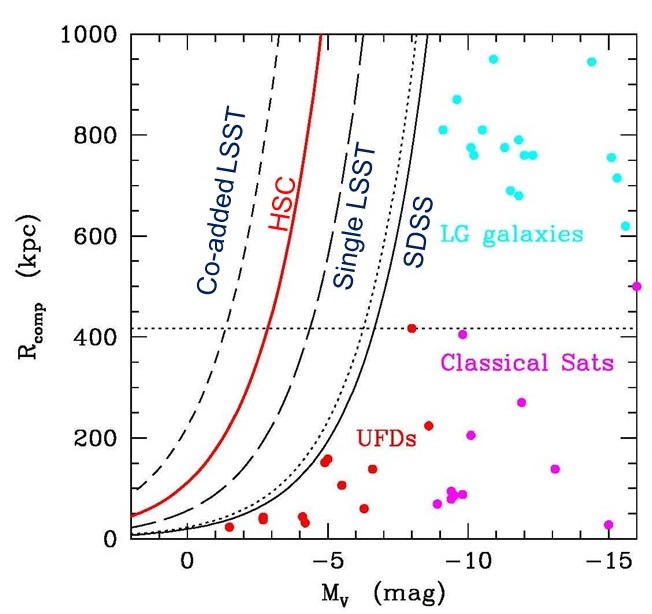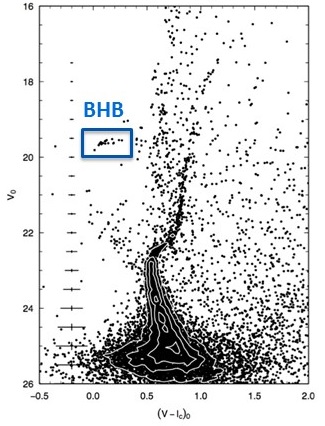Milky Way Science
Exploring the Faintest Galaxies in the Local Group
Using the wide-field (1,400 square degree) HSC data, we search for faint dwarf galaxies and halo substructures (in the form of stellar streams) that have yet to be detected in the Milky Way (MW) halo and the Local Group. This program will allow us to gain important insights into the so-called “missing satellite
problem” and thus constrain the faintest end of the galaxy luminosity distribution in the Local Group.
Recent systematic studies of Galactic stars in SDSS have led to the discovery of a previously unseen class of ultra-faint dwarf galaxies (UFDs) in the MW halo. While MW satellites brighter than M_V = -6 mag in the SDSS footprint have already been discovered and studied, the extremely faint (M_V > -4 mag) and more distant (d > 100 kpc) companions of the Galaxy still remain largely hidden in the sky, as they are much more difficult to find and confirm, even with SDSS’s depth (Figure 1). Indeed, a complete and well-defined census of these faint dwarfs is needed to assess the CDM model, which predicts the presence of several hundred dark matter satellites or subhalos around a MW-sized halo (the so-called “missing satellite problem”). Similarly, many faint dwarf galaxies in the Local Group, if they exist, still remain largely unidentified because they are fainter than SDSS’s depth. Thus, UFDs in the MW, as well as other dwarfs in the Local Group, are key to our fundamental understanding of the size and mass scale of dark matter clustering, the abundance and spatial distribution of dark matter subhalos, the extreme low mass limits of galaxy formation, and the formation history of the MW.
Right figure: Heliocentric distance plotted against Mv. Complete radius, R_comp, out to which dwarf satellites of a given M_v can be observed is indicated by the curves. HSC-SSP survey (red solid line), SDSS (black solid line), Skymapper (dotted line), and LSST (short dashed and long dashed lines). Figure adapted from Tollerud et al. 2008, ApJ, 688, 277.

3D Mapping of the Mikly Way Halo to Its Edge
We investigate the smooth matter distribution of the Galactic halo using blue horizontal branch (BHB) stars identified in the HSC wide-field survey. Due to their narrow range of absolute magnitudes, BHB stars can be used as bright and reliable standard candles. The multi-band deep survey will enable the construction of a detailed three-dimensional stellar map beyond the presumed edge of the Galactic halo.
The Galactic stellar distribution extends to at least 100 kpc in radius and follows a double power-law distribution. The majority of the outer halo is thought to have been built up from the accretion of satellite galaxies, and thus should be quite inhomogeneous and dominated by streams, clouds, and debris from infalling objects. However, current wide-field surveys have probed a relatively limited volume, identifying halo stars at distances only up to 80 kpc (Left panel of Figure 2). The distribution of stars beyond the presumed virial radius (~400 kpc) will allow us to place a limit on the size of the MW’s stellar halo, reveal its the outer halo structure, and characterize its accretion history.
BHB stars (Right panel of Figure 2) can be identified from multi-color photometry; the Paschen absorption,which falls in the z-band, is sensitive to surface gravity and it allows us to discriminate BHB stars from main sequence stars. With this technique, we explore the outer region of the Milky Way Galaxy.


Left: The spatial distribution of BHBs identified in the SDSS survey (Xue et al. 2011, ApJ, 738, 79). The Galactic center is located at the coordinate origin. The large filled circle indicates the location of the Sun (8.0 kpc, 0 kpc) and the stars are coded according to line-of-sight velocity.
Right: The color-magnitude diagram for Bootes I, a ultra-faint dwarf galaxy in the Milky Way (Okamoto et al. 2012, ApJ, 74, 96). The location of the BHB stars is depicted with a box.
